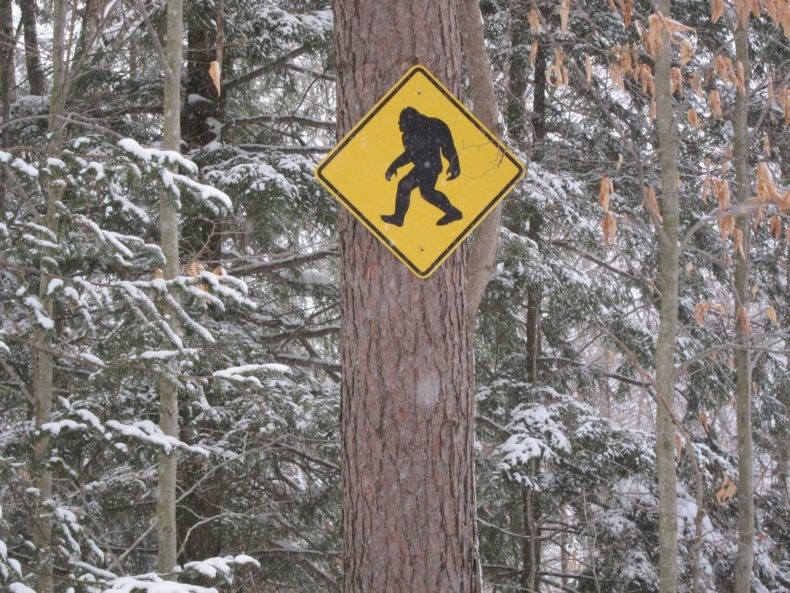
There’s a certain jolt that accompanies a good story idea. For me, it’s a physical sensation, as if I can feel my brain clicking all the right pieces into place. In a fleeting instant, I see the whole thing: the plot, the characters, the conflict, the brilliant overarching themes that really say something about our world. Of course, that vision falls apart as soon as I sit down to get it all on paper, but I’m always chasing that feeling.
In summer 2018, I was convinced that my next story was going to be about Bigfoot.
I saw some folks in a Facebook group talking about an upcoming Bigfoot expedition in the Olympic range, and that sent me down a day-long rabbit hole. I joined a Bigfoot Facebook group, I read about the group spearheading the expeditions, I scoured Reddit forums, I read first-person accounts of Big Foot encounters. My vision was to write a feature centered around a Bigfoot expedition that was at once scientifically rigorous and respectful of the Bigfoot researcher community. I imagined profiling expeditioners and researchers about why they search for Bigfoot in hopes of getting at how we form and hold on to beliefs, even if others don’t agree with us.
For weeks, I mulled over the best way to contact Bigfoot researchers. As an outsider, I knew it’d be a process to build trust with the right people. As a sign of respect, I wanted to make sure I knew enough about the key issues in the community before jumping in. The summer turned into fall, and other projects stole my attention; fall turned into winter. I let the idea simmer.
Like everything else in the world, writing follows the laws of physics: every action has an equal and opposite reaction. The flip of the great-idea-jolt is the sinking disappointment upon discovering someone has gotten to “my” story first. I can’t remember how I heard about Laura Krantz’s Wild Thing, a podcast about the hunt for Big Foot, but I do remember immediately thinking: Damnit, I should’ve worked faster. For a moment, I mourned “my” idea, then settled in to listen to the first episode.
A few minutes in, we learn that Krantz’s grandpa’s cousin, Grover Krantz, was a widely respected Big Foot researcher. A-ha, I thought, a way in! Surely, that gave her a boost, but after listening to the first season, it’s clear Krantz had done her homework. She identifies the various “factions” of Bigfoot enthusiasts, and carefully breaks down Bigfoot researchers’ work in the context of modern science. The result is far better than anything I could’ve hoped to make. It’s one of those masterworks that I imagine come to a person once or maybe twice in a lifetime, if you’re lucky: a story you’re uniquely positioned to tell, executed perfectly.
After devouring the podcast, I thought about how funny it was that Krantz and I had circled around the same ideas and thoughts independently, but she actually saw the idea through. (Not only that, but given the timing of the podcast, she’d likely done all her reporting before I even first thought of it.) And from that, she created something wonderful that I could enjoy without having to do the hard work.
A more recent instance of this illuminated what was wrong about my failed story idea. In 2015, I heard that Answers In Genesis, the creators of Kentucky’s Creation Museum, was building a replica of Noah’s Ark with a theme park inside, and I had a half-baked idea for a feature on the park’s museum curators and designers who built the ark: how does one reconcile creationism and the modern science you’d use to build a life-size ark and its exhibits? I let the idea languish for years; in that time, the Ark was built and there’s now a documentary about it called We Believe in Dinosaurs.
The documentary took that inkling I had — profiling the people who work in Ark Encounter — and made it much richer by also showcasing the park’s wider-reaching societal impacts. Ark Encounter was originally set to receive tax breaks from the state of Kentucky, despite the company’s religion-heavy standards for hiring, and scientists and activists have been vocal about this use of government funds. The documentarians also interviewed people living in Williamstown, a city just down the street from the Ark Encounter who sold Answers in Genesis the land for the park for just $1, based partly on the promise that the attraction would increase tourism in town. (Spoiler: Townfolk say that tourism hasn’t materialized.) It was clear that the documentary-makers had spent hundreds if hundreds if not thousands of hours interviewing sources, and following developments in Kentucky over the years, something I wouldn’t be able to commit to, and the result is a film that presents the people and politics of Kentucky with more nuance than most others I’ve seen.
I’ll admit that while watching, I realized I still wasn’t quite over “my” idea. There was one scene where the documentary-makers introduce a pastor who had been vocally opposed to creationist beliefs, and it took me a second to process my shock: I’d seen that pastor give a couple sermons last year, because he’s the pastor at the church I grew up going to. As he spoke, the stained-glass windows behind him looked the same as they did every Sunday I spent there, the same as they did when I was baptized in the small room behind them. If only I’d followed the thread of this story, I may have found myself back in familiar territory, at this church! But I didn’t, and they did. On to the next one.
Bigfoot photo by Flickr user Joe Shlabotnik.